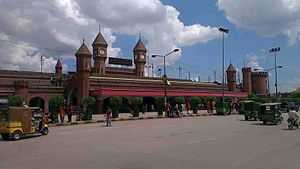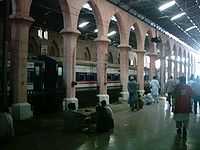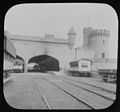Lahore Junction railway station
Lahore Junction railway station | |
|---|---|
 Front view of the station
Lahore Station | |
| Coordinates | 31°34′38″N 74°20′11″E / 31.5772°N 74.3363°ECoordinates: 31°34′38″N 74°20′11″E / 31.5772°N 74.3363°E |
| Owned by | Ministry of Railways |
| Line(s) | Karachi–Peshawar Main Line |
| Platforms | 11 |
| Tracks | 11 |
| Connections | Bus stand, Bus shelter, Taxicab stand |
| Construction | |
| Structure type | Standard (On Ground Station) |
| Other information | |
| Station code | LHR[1] |
| History | |
| Previous names | Great Indian Peninsular Railway |
The Lahore Junction railway station (Urdu: لاہور جنکشن ریلوے اسٹیشن ), (Punjabi: لہور جنکشن ریلوے اسٹیشن ) is the main Pakistan Railways terminus serving Lahore, Punjab, Pakistan. Built during the British Raj between 1859-1860 at the cost of half a million Rupees (approximately $30 million in 2015 US Dollars). Located in the heart of the city, it is the busiest railway station in the country, as well as the location for the headquarters of Pakistan Railways. Constructed in the typical grand architectural style of the British Raj period, it is a lasting legacy of the extensive railway network established by the British and their contribution to the infrastructure of the region.
The station has a total of eleven platforms. Platform Number One is noteworthy as the destination of the Samjhauta Express train service between India and Pakistan.
History
Lahore Junction railway station was commissioned by the British Government and construction was contracted to Mian Mohammad Sultan Chughtai, a formal prince of the Royal Mughal Empire. The front portion was disliked by the government (as seen in older photographs) and was subsequently rebuilt by Sultan Mohammad.
It was the western terminus of the crucial Lahore—Ghaziabad rail line which facilitated the vital connection of the furthest reaches of the Punjab to the capital of the British Raj; New Delhi. This allowed for the movement of people, goods, and revenue within, to and from the fertile and heavily-populated region.
The station was severely affected during the riots which followed the Partition of the British Indian Empire and the creation of Pakistan in 1947. Similar to the contemporaneous situation with migrating Muslims from Delhi; Lahore's Hindus and Sikhs migrating to India were frequently attacked and killed in large numbers. Many considered the station unsafe and opted to make the journey on foot.
Facilities
The Lahore Junction railway station has all the amenities of like-sized railway stations. Food and drink stalls and book shops are found on every platform. The franchises of American fast food chains McDonald's and Pizza Hut are located on platform number two.
Train services from Lahore Jn
Gallery
-

General View of Railway Station 1895 by William Henry Jackson
-
Far view of Railway Station in 1880s
-

Fortifications of Railway Station 1895 by William Henry Jackson
-

Railway Station in 1880s -

Railway Station Interior View 1880s -

Train platform at Lahore Railway Station -

Lahore - entrance to railway station 1895
-

Lahore - interior of railway station 1895
-

Lahore - general view of railway station 1895
See also
References
External links
| Wikimedia Commons has media related to Lahore Railway Station. |
| Preceding station | Lahore Junction railway station | Following station | ||
|---|---|---|---|---|
| Lahore Cantt. | Line Karachi–Peshawar Main Line |
Badami Bagh |
| ||||||||||||||||||||||||||||||||
| ||||||||||||||||||||||||||
